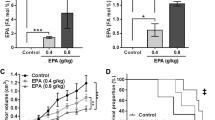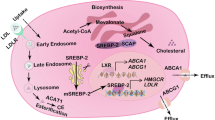Abstract
The schweinfurthins have potent antiproliferative activity in multiple glioblastoma multiforme (GBM) cell lines; however, the mechanism by which growth is impeded is not fully understood. Previously, we demonstrated that the schweinfurthins reduce the level of key isoprenoid intermediates in the cholesterol biosynthetic pathway. Herein, we describe the effects of the schweinfurthins on cholesterol homeostasis. Intracellular cholesterol levels are greatly reduced in cells incubated with 3-deoxyschweinfurthin B (3dSB), an analog of the natural product schweinfurthin B. Decreased cholesterol levels are due to decreased cholesterol synthesis and increased cholesterol efflux; both of these cellular actions can be influenced by liver X-receptor (LXR) activation. The effects of 3dSB on ATP-binding cassette transporter 1 levels and other LXR targets are similar to that of 25-hydroxycholesterol, an LXR agonist. Unlike 25-hydroxycholesterol, 3dSB does not act as a direct agonist for LXR α or β. These data suggest that cholesterol homeostasis plays a significant role in the growth inhibitory activity of the schweinfurthins and may elucidate a mechanism that can be targeted in human cancers such as GBM.






Similar content being viewed by others
Abbreviations
- 3dSB:
-
3-Deoxyschweinfurthin B
- LXR:
-
Liver X receptor
- NCI60:
-
National Cancer Institute 60 cell cancer screen
- CNS:
-
Central nervous system
References
Beutler JA, Shoemaker RH, Johnson T, Boyd MR (1998) Cytotoxic geranyl stilbenes from Macaranga schweinfurthii. J Nat Prod 61:1509–1512
Covell DG, Huang RL, Wallqvist A (2007) Anticancer medicines in development: assessment of bioactivity profiles within the National Cancer Institute anticancer screening data. Mol Cancer Ther 6:2261–2270
Beutler JA, Shoemaker RH, Johnson T, Boyd MR (1998) Cytotoxic geranyl stilbenes from Macaranga schweinfurthii. J Nat Prod 61:1509–1512
Stupp R, Mason WP, van den Bent MJ, Weller M, Fisher B, Taphoorn MJB, Belanger K, Brandes AA, Marosi C, Bogdahn U, Curschmann J, Janzer RC, Ludwin SK, Gorlia T, Allgeier A, Lacombe D, Cairncross JG, Eisenhauer E, Mirimanoff RO (2005) Radiotherapy plus Concomitant and Adjuvant Temozolomide for Glioblastoma. N Engl J Med 352:987–996
Ohka F, Natsume A, Wakabayashi T (2012) Current Trends in Targeted Therapies for Glioblastoma Multiforme. Neurol Res Int 2012:13
Kuder CH, Neighbors JD, Hohl RJ, Wiemer DF (2009) Synthesis and biological activity of a fluorescent schweinfurthin analogue. Bioorganic Med Chem 17:4718–4723
Mente NR, Neighbors JD, Wiemer DF (2008) BF3 × Et2O-mediated cascade cyclizations: synthesis of schweinfurthins F and G. J Org Chem 73:7963–7970
Mente NR, Wiemer AJ, Neighbors JD, Beutler JA, Hohl RJ, Wiemer DF (2007) Total synthesis of (R, R, R)- and (S, S, S)-schweinfurthin F: differences of bioactivity in the enantiomeric series. Bioorg Med Chem Lett 17:911–915
Neighbors JD, Beutler JA, Wiemer DF (2005) Synthesis of nonracemic 3-deoxyschweinfurthin B. J Org Chem 70:925–931
Neighbors JD, Salnikova MS, Beutler JA, Wiemer DF (2006) Synthesis and structure-activity studies of schweinfurthin B analogs: evidence for the importance of a D-ring hydrogen bond donor in expression of differential cytotoxicity. Bioorg Med Chem 14:1771–1784
Topczewski JJ, Callahan MP, Kodet JG, Inbarasu JD, Mente NR, Beutler JA, Wiemer DF (2011) Relevance of the C-5 position to schweinfurthin induced cytotoxicity. Bioorg Med Chem 19:7570–7581
Topczewski JJ, Kodet JG, Wiemer DF (2011) Exploration of cascade cyclizations terminated by tandem aromatic substitution: total synthesis of (+)-schweinfurthin A. J Org Chem 76:909–919
Topczewski JJ, Kuder CH, Neighbors JD, Hohl RJ, Wiemer DF (2010) Fluorescent schweinfurthin B and F analogs with anti-proliferative activity. Bioorg Med Chem 18:6734–6741
Treadwell EM, Neighbors JD, Wiemer DF (2002) A cascade cyclization approach to schweinfurthin B. Org Lett 4:3639–3642
Ulrich NC, Kodet JG, Mente NR, Kuder CH, Beutler JA, Hohl RJ, Wiemer DF (2010) Structural analogues of schweinfurthin F: probing the steric, electronic, and hydrophobic properties of the D-ring substructure. Bioorg Med Chem 18:1676–1683
Ulrich NC, Kuder CH, Hohl RJ, Wiemer DF (2010) Biologically active biotin derivatives of schweinfurthin F. Bioorg Med Chem Lett 20:6716–6720
Turbyville TJ, Gursel DB, Tuskan RG, Walrath JC, Lipschultz CA, Lockett SJ, Wiemer DF, Beutler JA, Reilly KM (2010) Schweinfurthin a selectively inhibits proliferation and Rho signaling in glioma and neurofibromatosis type 1 tumor cells in a NF1-GRD-dependent manner. Mol Cancer Ther 9:1234–1243
Holstein SA, Kuder CH, Tong H, Hohl RJ (2011) Pleiotropic effects of a schweinfurthin on isoprenoid homeostasis. Lipids 46:907–921
Luu W, Sharpe LJ, Gelissen IC, Brown AJ (2013) The role of signalling in cellular cholesterol homeostasis. IUBMB Life 65:675–684
Wang Y, Rogers PM, Su C, Varga G, Stayrook KR, Burris TP (2008) Regulation of cholesterologenesis by the oxysterol receptor, LXRα. J Biol Chem 283:26332–26339
Sorrentino V, Nelson JK, Maspero E, Marques ARA, Scheer L, Polo S, Zelcer N (2013) The LXR-IDOL axis defines a clathrin-, caveolae-, and dynamin-independent endocytic route for LDLR internalization and lysosomal degradation. J Lipid Res 54:2174–2184
Kuder CH, Neighbors JD, Hohl RJ, Wiemer DF (2009) Synthesis and biological activity of a fluorescent schweinfurthin analogue. Bioorg Med Chem 17:4718–4723
Sekiya M, Yamamuro D, Ohshiro T, Honda A, Takahashi M, Kumagai M, Sakai K, Nagashima S, Tomoda H, Igarashi M, Okazaki H, Yagyu H, Osuga J, Ishibashi S (2014) Absence of Nceh1 augments 25-hydroxycholesterol-induced ER stress and apoptosis in macrophages. J Lipid Res 55:2082–2092
Kodet JG, Beutler JA, Wiemer DF (2014) Synthesis and structure activity relationships of schweinfurthin indoles. Bioorg Med Chem 22:2542–2552
Neighbors JD, Salnikova MS, Beutler JA, Wiemer DF (2006) Synthesis and structure–activity studies of schweinfurthin B analogs: evidence for the importance of a D-ring hydrogen bond donor in expression of differential cytotoxicity. Bioorg Med Chem 14:1771–1784
Sinensky M, Beck LA, Leonard S, Evans R (1990) Differential inhibitory effects of lovastatin on protein isoprenylation and sterol synthesis. J Biol Chem 265:19937–19941
Kuder CH, Sheehy RM, Neighbors JD, Wiemer DF, Hohl RJ (2012) Functional evaluation of a fluorescent schweinfurthin: mechanism of cytotoxicity and intracellular quantification. Mol Pharmacol 82:9–16
Paull KD (1995) Prediction of biochemical mechanism of action from the in vitro antitumor screen of the National Cancer Institute. In: Foye WO (ed) Cancer chemotherapeutic agents. American Chemical Society, Washington, DC, pp 9–45
Beutler JA, Jato J, Cragg G, Wiemer DF, Neighbors JD, Salnikova MS, Hollingshead M, Scudiero DA, McCloud TG (2005) The schweinfurthins: issues in development of a plant-derived anticancer lead. In: Bogers RJ, (ed) Medicinal and aromatic plants. Springer, New York, pp 301–309
Holstein SA, Kuder CH, Tong H, Hohl RJ (2011) Pleiotropic effects of a schweinfurthin on isoprenoid homeostasis. Lipids 46:907–921
Heverin M, Meaney S, Lutjohann D, Diczfalusy U, Wahren J, Bjorkhem I (2005) Crossing the barrier: net flux of 27-hydroxycholesterol into the human brain. J Lipid Res 46:1047–1052
Maletinska L, Blakely EA, Bjornstad KA, Deen DF, Knoff LJ, Forte TM (2000) Human glioblastoma cell lines: levels of low-density lipoprotein receptor and low-density lipoprotein receptor-related protein. Cancer Res 60:2300–2303
Ma DQ, Nutt CL, Shanehsaz P, Peng XJ, Louis DN, Kaetzel DM (2005) Autocrine platelet-derived growth factor-dependent gene expression in glioblastoma cells is mediated largely by activation of the transcription factor sterol regulatory element binding protein and is associated with altered genotype and patient survival in human brain tumors. Cancer Res 65:5523–5534
Janowski BA, Willy PJ, Devi TR, Falck JR, Mangelsdorf DJ (1996) An oxysterol signalling pathway mediated by the nuclear receptor LXR alpha. Nature 383:728–731
Brown MS, Goldstein JL (1997) The SREBP pathway: regulation of cholesterol metabolism by proteolysis of a membrane-bound transcription factor. Cell 89:331–340
Schultz JR, Tu H, Luk A, Repa JJ, Medina JC, Li LP, Schwendner S, Wang S, Thoolen M, Mangelsdorf DJ, Lustig KD, Shan B (2000) Role of LXRs in control of lipogenesis. Genes Dev 14:2831–2838
Baldan A, Bojanic DD, Edwards PA (2009) The ABCs of sterol transport. J Lipid Res 50:S80–S85
Rohrl C, Eigner K, Winter K, Korbelius M, Obrowsky S, Kratky D, Kovacs WJ, Stangl H (2014) Endoplasmic reticulum stress impairs cholesterol efflux and synthesis in hepatic cells. J Lipid Res 55:94–103
Kuder CH, Sheehy RM, Neighbors JD, Wiemer DF, Hohl RJ (2012) Functional Evaluation of a Fluorescent Schweinfurthin: mechanism of Cytotoxicity and Intracellular Quantification. Mol Pharmacol 82:9–16
Castilho G, Okuda LS, Pinto RS, Iborra RT, Nakandakare ER, Santos CX, Laurindo FR, Passarelli M (2012) ER stress is associated with reduced ABCA-1 protein levels in macrophages treated with advanced glycated albumin—reversal by a chemical chaperone. Int J Biochem Cell Biol 44:1078–1086
Burgett AW, Poulsen TB, Wangkanont K, Anderson DR, Kikuchi C, Shimada K, Okubo S, Fortner KC, Mimaki Y, Kuroda M, Murphy JP, Schwalb DJ, Petrella EC, Cornella-Taracido I, Schirle M, Tallarico JA, Shair MD (2011) Natural products reveal cancer cell dependence on oxysterol-binding proteins. Nat Chem Biol 7:639–647
Bowden K, Ridgway ND (2008) OSBP negatively regulates ABCA1 protein stability. J Biol Chem 283:18210–18217
Guo D, Reinitz F, Youssef M, Hong C, Nathanson D, Akhavan D, Kuga D, Amzajerdi AN, Soto H, Zhu S, Babic I, Tanaka K, Dang J, Iwanami A, Gini B, DeJesus J, Lisiero DD, Huang TT, Prins RM, Wen PY, Robins HI, Prados MD, DeAngelis LM, Mellinghoff IK, Mehta MP, James CD, Chakravarti A, Cloughesy TF, Tontonoz P, Mischel PS (2011) An LXR agonist promotes glioblastoma cell death through inhibition of an EGFR/AKT/SREBP-1/LDLR—dependent pathway. Cancer Discov 1:442–456
Financial Support Statement
This project was supported in part by the Roy J. Carver Charitable Trust, the Roland W. Holden Family Program for Experimental Therapeutics, and the National Institutes of Health (5R42NS069272).
Author information
Authors and Affiliations
Corresponding author
About this article
Cite this article
Kuder, C.H., Weivoda, M.M., Zhang, Y. et al. 3-Deoxyschweinfurthin B Lowers Cholesterol Levels by Decreasing Synthesis and Increasing Export in Cultured Cancer Cell Lines. Lipids 50, 1195–1207 (2015). https://doi.org/10.1007/s11745-015-4083-z
Received:
Accepted:
Published:
Issue Date:
DOI: https://doi.org/10.1007/s11745-015-4083-z




